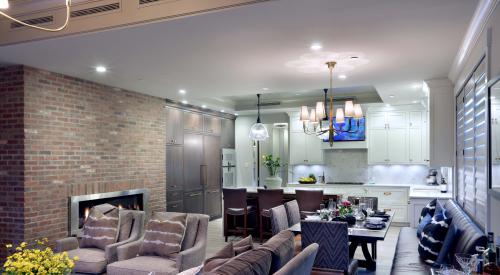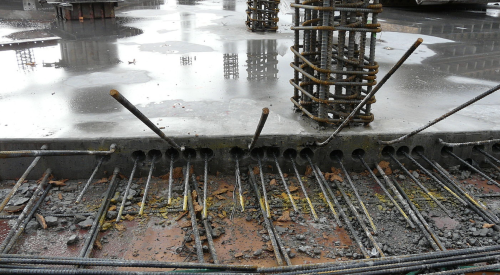In today's marketplace, custom tile showers are in high demand; they add beauty and value to any home. However, while tile showers are some of the most attractive spaces, they definitely fall among the ugliest when it comes to wasting money and drowning customer satisfaction ratings and company reputation. Shifting from preformed surrounds to custom designs has led to a significant increase in the possibility of — what else — water intrusion. And the costs could surprise you.
Why Showers?The bathroom is one of the harshest environments in a home. Building materials constantly battle water and moisture from multiple sources; however, no source is more problematic than the shower, placing this area of the home on the list of common warranty callbacks.
Showers experience a high concentration of water at once — on average, 2.5 gallons per minute. There are multiple transitions from one material to another, such as glass to tile. There are also multiple instances where one plane intersects another, such as at a shower seat. These tricky areas have to be treated with care to prevent water from entering the building assembly.
Warning Signs of Water IntrusionThe top two signs of water intrusion that homeowners notice are water stains and a musty smell. However, water stains and smells are only a few signs that water management may have gone awry during the shower installation. It's important not to assume a shower is waterproof simply because there are no visible signs of damage. A lot may be going on behind the scenes before mold grows on the grout, cracks appear in the tile, or other water damage occurs around and below the shower unit. In most cases, water damage from a shower can take a week or more to repair. Without a shower to use during this period, homeowners feel frustrated and unhappy, especially if the repair has a significant impact on their daily routine.
Mold on the MindWhen water damage is a concern, mold is likely to follow close behind. And with the significant attention mold has received in the media lately, it's usually the first thing on homeowners' minds as well. Increased mold growth in new homes has caused concern for both homeowners and the building industry.
For builders, mold is the ultimate headache. Once mold enters the picture, the repair grows from just rework to a combined rework and mold remediation effort. Typically, the costs more than double when mold remediation is involved.
For one builder, this became crystal clear when more than 450 homes in a single community began to show signs of shower-related water damage. When moisture was discovered, the builder brought in a certified mold assessor to determine whether or not mold was present. When the assessor found mold, a second company had to be hired to conduct mold remediation. Because approximately 70 homes had signs of mold growth, the builder's costs hit nearly $7,000 per home on mold remediation alone.
Add that cost on top of the demolition and reinstallation work for 450 homes, and the total costs were estimated to reach $2.7 million — and that's not including the costs to the builder's productivity, customer satisfaction ratings and reputation.
A Dance Between TradesA shower installation is a complex dance between trades. Multiple trades install different parts of a shower at different times during a home's construction of the home. Some trades are directly involved with the installation, such as the plumber, and others are more indirectly involved, like the framer. With so many trades, it's frequently difficult to immediately identify who and what caused a problem without tearing out the shower. As a result, it's best to identify problems before they're covered up by inspecting the previous trade's work.
Here's an example of common mistakes made at each stage of construction:
- Framer: Frames the shower seat without a positive slope toward the shower drain.
- Plumber: Installs the shower pan and liner but doesn't lap the liner correctly over the lip of the pan.
- Insulation installer: Pulls down the liner to fill the space behind it with insulation but doesn't put the liner back up afterward.
- Drywall installer: Installs gypsum drywall instead of backer board and covers over the mistakes made by the framer, plumber and insulation installer.
- Tile setter: Plugs the weep holes and grouts the transitions between different planes instead of caulking them.
- Shower surround installer: Poorly seals between the glass surround and the tile surface.
Each of these mistakes can lead to water damage and mold growth. Although it may seem like a bit much to assume that six trades can make so many mistakes, this is exactly what happened to the builder with $2.7 million in water damage and mold remediation costs.
Lessons LearnedAt each stage of construction, successive trades must take care not to compound or cover up a previous trade's defect nor create their own. Covering a defect hides the problem and can often exacerbate the situation. It's imperative that each stage of work be carefully inspected by your site supervisor before the next trade begins.
Having a comprehensive water management strategy in place is the highest goal. Surprisingly, many shower installations don't have a solid strategy in place to prevent water from reaching sensitive building materials. With this in mind, a shower should have a secondary or back-up measure in place to guide water to the drain. Tiles are naturally water-resistant and act as the primary drainage plane, but the grout between them is porous and absorbs water. The water absorbed by the grout has to be able to dry or drain away. By installing a liner as the secondary drainage plane, water that saturates the grout is kept away from sensitive materials and directed toward the drain.
The most important concept to remember is to always guide water down and out. This concept holds true no matter whether you're talking about a shower or the exterior of a home. Allowing water into places it shouldn't be can only lead to problems down the road.
With the housing market down on its knees and with the inability to increase home sale prices, it's become more important than ever for housing giants to focus on operational excellence to salvage more profit for their bottom line. Ensure critical spaces are built right the first time by arming your teams with fundamental knowledge and industry best practices. Doing so will help you save money and reduce risk at the same time.
| Author Information |
| Michael Dickens is the CEO of BuildIQ, which provides online information, tools and training in home building best practices to help builders take their homes and businesses to the next level of quality and performance. |











